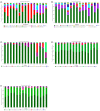Intestinal Microbiota Community and Blood Fatty Acid Profiles of Albas Cashmere Goats Fed with Flaxseed Oil and Whole Flaxseed
- PMID: 38003148
- PMCID: PMC10668713
- DOI: 10.3390/ani13223531
Intestinal Microbiota Community and Blood Fatty Acid Profiles of Albas Cashmere Goats Fed with Flaxseed Oil and Whole Flaxseed
Abstract
The present study investigated the effects of flaxseed oil or flaxseed grain on the intestinal microbiota and blood fatty acid profiles of Albas cashmere goats. Sixty kid goats were allocated to three treatments and fed for 90 days with a control treatment, comprising a basal diet (CON, total-mixed ration with flaxseed meal), or experimental treatments, comprising a basal diet with added flaxseed oil (LNO) and a basal diet with added heated flaxseed grain (HLS). On day 90, two goats were randomly selected from each pen (eight goats per treatment) for euthanizing; then, five of the eight goats were randomly selected, and we collected their intestinal (duodenum, jejunum, ileum, cecum, and colon) digesta for analysis of the bacteria community. The results indicated that Firmicutes are the most predominant phylum in different segments of the intestinal digesta. Compared with the CON group, the relative abundance of duodenal Firmicutes, jejunal Saccharibacteria, and Verrucomicrobia significantly decreased in the LNO and HLS groups (p < 0.05), but there was no significant difference between the LNO and HLS groups. Compared with the CON and HLS groups, the RA of duodenal and jejunal Proteobacteria remarkably increased in the LNO group (p < 0.05), and there was no significant difference between the CON and HLS groups. Compared with the CON and LNO groups, the RA of Actinobacteria remarkably increased in the small intestine of the HLS group (p < 0.05), but there was no significant difference between the CON and LNO groups in the duodenum and ileum. The results of linear discriminant analysis (LDA) effect size (LEfSe) analysis showed that the HLS group was characterized by a higher RA of the [Eubacterium]_coprostanoligenes_group in the small intestine and the LNO group was represented by a higher RA of the Lachnospiraceae_NK3A20_group in the cecum and colon, while the CON group was represented by a higher RA of Solobacterium, Pseudoramibacter, and Acetitomaculum in the small intestine and a higher RA of norank_o__Bradymonadales, the Prevotellaceae_Ga6A1_group, and Ruminiclostridium_1 in the cecum and colon. In conclusion, the addition of flaxseed oil and grain rich in c18:3n3 to the diet could reduce the microbial diversity of the small intestinal segments and the microbial diversity and richness of the cecum and colon in Albas cashmere goats. And flaxseed grain is more efficient than flaxseed oil in protecting intestinal health and promoting the absorption of c18:3n3.
Keywords: bacteria; different intestinal segments; goat; grain; n-3 poly-unsaturated fatty acids.
Conflict of interest statement
The authors declare no conflict of interest.
Figures








Similar articles
-
Flaxseed Oil and Heated Flaxseed Supplements Have Different Effects on Lipid Deposition and Ileal Microbiota in Albas Cashmere Goats.Animals (Basel). 2021 Mar 12;11(3):790. doi: 10.3390/ani11030790. Animals (Basel). 2021. PMID: 33809169 Free PMC article.
-
Linseed oil and heated linseed grain supplements have different effects on rumen bacterial community structures and fatty acid profiles in cashmere kids1.J Anim Sci. 2019 Apr 29;97(5):2099-2113. doi: 10.1093/jas/skz079. J Anim Sci. 2019. PMID: 30840990 Free PMC article.
-
The mechanism through which dietary supplementation with heated linseed grain increases n-3 long-chain polyunsaturated fatty acid concentration in subcutaneous adipose tissue of cashmere kids.J Anim Sci. 2019 Jan 1;97(1):385-397. doi: 10.1093/jas/sky386. J Anim Sci. 2019. PMID: 30312437 Free PMC article.
-
The Ruminal Microbiome Alterations Associated with Diet-Induced Milk Fat Depression and Milk Fat Globule Size Reduction in Dairy Goats.Animals (Basel). 2024 Sep 9;14(17):2614. doi: 10.3390/ani14172614. Animals (Basel). 2024. PMID: 39272399 Free PMC article.
-
Supplementing Mannan Oligosaccharide Reduces the Passive Transfer of Immunoglobulin G and Improves Antioxidative Capacity, Immunity, and Intestinal Microbiota in Neonatal Goats.Front Microbiol. 2022 Jan 4;12:795081. doi: 10.3389/fmicb.2021.795081. eCollection 2021. Front Microbiol. 2022. PMID: 35058910 Free PMC article.
Cited by
-
Pain, obesity, adenosine salvage disruption, and smoking behavior mediate the effect of gut microbiota on sleep disorders: results from network Mendelian randomization and 16S rDNA sequencing.Front Microbiol. 2024 Jul 31;15:1413218. doi: 10.3389/fmicb.2024.1413218. eCollection 2024. Front Microbiol. 2024. PMID: 39144232 Free PMC article.
-
Edible plant oils modulate gut microbiota during their health-promoting effects: a review.Front Nutr. 2024 Sep 30;11:1473648. doi: 10.3389/fnut.2024.1473648. eCollection 2024. Front Nutr. 2024. PMID: 39403395 Free PMC article. Review.
References
-
- Wang X., Wu T., Yan S., Shi B., Zhang Y., Guo X. Influence of pasture or total mixed ration on fatty acid composition and expression of lipogenic genes of longissimus thoracis and subcutaneous adipose tissues in albas white cashmere goats. Ital. J. Anim. Sci. 2018;18:1–13. doi: 10.1080/1828051X.2018.1490632. - DOI
-
- Wang X., Martin G.B., Liu S., Shi B., Guo X., Zhao Y., Yan S. The mechanism through which dietary supplementation with heated linseed grain increases n-3 long-chain polyunsaturated fatty acid concentration in subcutaneous adipose tissue of cashmere kids. J. Anim. Sci. 2019;97:385–397. doi: 10.1093/jas/sky386. - DOI - PMC - PubMed
Grants and funding
LinkOut - more resources
Full Text Sources

